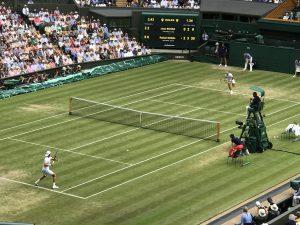We may earn money or products from the companies mentioned in this post.
A Quick Summary

Tennis has a unique scoring system that has been around for centuries, rooted in medieval French numerology. The traditional 15-30-40 system is the most common, but an alternative no-ad format has been introduced. Understanding the scoring system can help players improve their skills and add excitement and strategy to the game. The choice of scoring format depends on the preferences of players and tournament organizers.
Introduction to Tennis Scoring System

Tennis is a sport that has been played for centuries, with roots dating back to 12th century France Over time, the game has evolved and adapted, but one aspect that remains constant is the scoring system The tennis scoring system can be confusing for those new to the sport, but it is crucial to understand in order to fully appreciate and enjoy the game
Brief History of Tennis Scoring
The origins of tennis scoring are not entirely clear, but it is believed that the modern method was developed in medieval France At this time, players would use their hand to hit a ball against a wall or over a rope strung across a courtyard Points were awarded based on how far the opponent had to run before returning the ball
As the sport evolved and moved indoors, new rules were established and eventually led to what we know as modern tennis today The current scoring system was developed in England during the 19th century and has remained largely unchanged since then
Importance of Understanding Tennis Scoring
Understanding tennis scoring is important because it allows viewers and participants alike to fully engage with the game Knowing how points are earned and what it takes to win each set can add excitement and strategy to watching or playing tennis
Additionally, having knowledge of tennis scoring can help players improve their skills by allowing them to strategically plan out their moves during each point based on where they stand in relation to their opponent’s score
Overview of Unique 15-30-40 Scoring Method
The unique 15-30-40 scoring method used in tennis may seem odd at first glance; however, once understood, it becomes an integral part of enjoying this classic sport
Each game starts with a score of “love-all,” meaning zero points for both players The first point earned is worth 15, the second point is worth 30, and the third point is worth 40 If both players are tied at three points each (40-all), it is referred to as deuce
In order to win a game, a player must win by two points This means that if the score reaches deuce, the next point won will give that player advantage If they win the following point as well, they will have won the game
The scoring system in tennis may seem complicated at first, but it adds an extra layer of excitement and strategy to this beloved sport By understanding how points are earned and what it takes to win each set, viewers can fully engage with the action on the court and appreciate all that tennis has to offer
| Key Point | Description |
|---|---|
| 1. Winning by two points | A player must win a game by at least two points |
| 2. Deuce | Score is tied at 40-all, requiring one player to gain advantage and then win a point to win the game |
| 3. Advantage | Player wins a point after deuce, needing to win one more point for the game victory |
Origins and rationale behind the 15-30-40 scoring system in tennis

Influence of medieval French numerology in tennis scoring
The origins of the 15-30-40 scoring system can be traced back to medieval France and its fascination with numerology The French believed that certain numbers held mystical powers and used them in everything from architecture to sports
One example of this is the connection between the clock face theory and tennis scoring In medieval times, clocks only had an hour hand, which meant that a full rotation took 12 hours To keep track of time in half-hour increments, they divided each hour into 30-minute segments
Similarly, tennis courts were divided into halves, with each half representing 15 points This is where the first two scores (15 and 30) came from The last score, 40, was likely chosen because it rhymed with “deuce,” another term used in tennis
Another influence on the scoring system was the game of “jeu de paume,” which was played in France during the Middle Ages and is considered an ancestor to modern-day tennis In this game, players would score points by hitting a ball over a net or against a wall The first player to reach 60 points won the game
The “quadrants” theory and its impact on tennis scoring increments
In addition to numerology, another theory that influenced the development of the tennis scoring system was the concept of quadrants Tennis courts were divided into four sections or quadrants: two for serving and two for returning serves
Each quadrant represented different levels of difficulty for players depending on their position on the court To reflect these differences, scores were incremented by larger amounts as players got closer to winning a game
For example, once a player reached a score of 40 (which represented three quadrants), they needed to win the next point to win the game This system allowed for more dramatic comebacks and added excitement to the game
In conclusion, the 15-30-40 scoring system in tennis has its roots in medieval French numerology and the concept of quadrants While it may seem arbitrary at first glance, it’s clear that a great deal of thought went into its development and continues to shape how we play tennis today
| Key Point | Explanation |
|---|---|
| Medieval French | Numerology influenced the 15-30-40 scoring system in tennis |
| Concept of Quadrants | Tennis courts were divided into quadrants, affecting score increments |
| Dramatic Comebacks | The scoring system allowed for exciting comebacks and game dynamics |
Explanation of the 15-30-40 Scoring System and Associated Terminologies

Detailed Breakdown of Points Progression in a Game
When it comes to tennis, understanding the scoring system can be intimidating for beginners The game is divided into points, games, sets, and matches Each point won is counted as one point, with four points making up a game and six games making up a set In professional tournaments, players must win three out of five sets to win the match
One term that often confuses new tennis enthusiasts is ‘Love’ This term represents zero points in tennis lingo and has been theorized to have originated from the French word ‘l’oeuf,’ meaning egg It’s thought that because an egg looks like a zero, it was used to represent no points
Deuce, Advantage, and Tiebreak Rules within the Context of this Unique Scoring System
In tennis scoring, deuce refers to a scenario where both players reach equal scores at or above 40 points When this happens, one player must win two consecutive points to win the game This rule ensures that games don’t go on indefinitely
Advantage rules come into play when one player wins the first point after deuce At this stage, they gain an advantage over their opponent but must then secure another point to win the game
Another aspect unique to tennis is tiebreaks; these occur when players reach six games all in a set and need to determine who will win that particular set before moving onto the next one In tiebreaks, players compete until one reaches seven points while also being two ahead of their opponent
Understanding these terminologies will help you appreciate tennis better and make watching matches much more enjoyable!
| Term | Description | Point to Win |
|---|---|---|
| Deuce | Both players have equal scores at or above 40 | Win 2 consecutive points |
| Advantage | One player wins first point after deuce | Win the next point |
| Tiebreak | Players reach six games all in a set | Reach 7 points, be 2 ahead of opponent |
Variations and Alternatives to the Traditional 15-30-40 Tennis Scoring System

Introduction to No-Ad (No Advantage) Scoring Format
When it comes to playing tennis, the traditional scoring system of 15-30-40 can be challenging for beginners and even some seasoned players To address this issue, an alternative scoring format called no-ad (no advantage) has been introduced This format is particularly useful in recreational play or tournaments with time constraints since it shortens game durations
In a no-ad scoring format, winning by two points is not required at deuce Instead, the first player or team to reach four points wins the game If both sides score three points each, a sudden-death point is played where the winner takes all
Comparison Between Traditional & Alternative Systems – Pros & Cons
While traditional tennis scoring has been around for centuries and remains popular today, alternative systems like no-ad have their own set of pros and cons that are worth considering
One benefit of no-ad scoring is that games tend to be shorter than in the traditional system This can be advantageous when time constraints are present or in situations where players want to fit more games into a limited amount of time
On the other hand, some players may prefer the traditional system because it allows for longer games that test endurance and strategic thinking Additionally, since winning by two points is required at deuce in traditional scoring, there’s more opportunity for excitement as players try to gain an advantage over their opponent
When it comes to viewership experience, both systems have their unique strengths and weaknesses While traditional scoring may be more familiar to audiences who have grown up watching tennis matches on TV or in-person events, no-ad can provide faster-paced action that keeps fans engaged throughout shorter games
Overall, both traditional and alternative tennis scoring formats have their advantages and disadvantages Which one to use ultimately depends on the preferences of players and tournament organizers, as well as the specific context in which games are being played
| Aspect | Traditional Scoring | No-Ad Scoring |
|---|---|---|
| Game Duration | Longer games | Shorter games |
| Familiarity | More familiar to viewers | Less familiar |
| Pace and Engagement | Slower-paced action | Faster-paced action |
Useful Links

Why is Tennis Scoring So Weird?
Why Is Tennis Scoring 15 30 40
The Tennis Scoring System
Why is the scoring at tennis so strange (15, 30, 40 deuce …
TENNIS SCORES | MATHCOUNTS Foundation
Why does the scoring system go 15, 30 and 40 in tennis …
Why Is Tennis Scored 15 30 40? (With 3 Theorys)
This is why the scores in tennis are 15, 30 and 40… …
Why are tennis points 15, 30 and 40? Scoring system …
How Does Tennis Scoring Work?
The History of the Tennis Scoring System
Why does tennis score by 15/30/40 rather than simply 1/2/3?
Tennis Scoring Explained | Play Tennis
Why Is Tennis Scoring So Weird? – A Guide For All Beginners
Learn What The Term Love Means In Tennis
Tennis Scoring 101
Why is tennis scored the way it is? The love, 15, 30 and 40 …
The Possible Origins Of The Tennis Scoring System, Part …
How to Keep Score in Tennis






